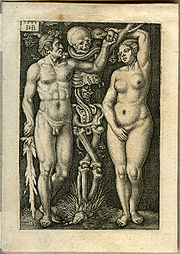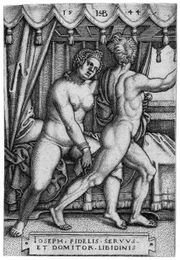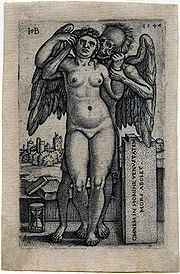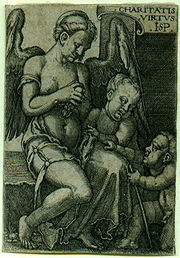
Hans Sebald Beham
Encyclopedia



Germany
Germany , officially the Federal Republic of Germany , is a federal parliamentary republic in Europe. The country consists of 16 states while the capital and largest city is Berlin. Germany covers an area of 357,021 km2 and has a largely temperate seasonal climate...
printmaker
Printmaking
Printmaking is the process of making artworks by printing, normally on paper. Printmaking normally covers only the process of creating prints with an element of originality, rather than just being a photographic reproduction of a painting. Except in the case of monotyping, the process is capable...
who did his best work as an engraver
Engraving
Engraving is the practice of incising a design on to a hard, usually flat surface, by cutting grooves into it. The result may be a decorated object in itself, as when silver, gold, steel, or glass are engraved, or may provide an intaglio printing plate, of copper or another metal, for printing...
, and was also a designer of woodcut
Woodcut
Woodcut—occasionally known as xylography—is a relief printing artistic technique in printmaking in which an image is carved into the surface of a block of wood, with the printing parts remaining level with the surface while the non-printing parts are removed, typically with gouges...
s and a painter and miniaturist. He is one of the most important of the "Little Masters
Little Masters
The Little Masters , were a group of German printmakers who worked in the first half of the 16th century, primarily in engraving. They specialized in very small finely detailed prints, some no larger than a postage stamp...
", the group of German artists making old master print
Old master print
An old master print is a work of art produced by a printing process within the Western tradition . A date of about 1830 is usually taken as marking the end of the period whose prints are covered by this term. The main techniques concerned are woodcut, engraving and etching, although there are...
s in the generation after Dürer.
Life

Barthel Beham
Barthel Beham was a German engraver, miniaturist and painter.The younger brother of Hans Sebald Beham, he was born into a family of artists in Nuremberg...
by two years, he was born into a family of artist
Artist
An artist is a person engaged in one or more of any of a broad spectrum of activities related to creating art, practicing the arts and/or demonstrating an art. The common usage in both everyday speech and academic discourse is a practitioner in the visual arts only...
s in Nuremberg
Nuremberg
Nuremberg[p] is a city in the German state of Bavaria, in the administrative region of Middle Franconia. Situated on the Pegnitz river and the Rhine–Main–Danube Canal, it is located about north of Munich and is Franconia's largest city. The population is 505,664...
. In 1525, along with his brother and Georg Pencz
Georg Pencz
Georg Pencz was a German engraver, painter and printmaker.Pencz travelled to Nuremberg in 1523 and joined Albrecht Dürer’s atelier. Like Dürer, he visited Italy and was profoundly influenced by Venetian art and it is believed he worked with Marcantonio Raimondi...
, the so-called "godless painters", he was banished from Nuremberg, accused of heresy
Heresy
Heresy is a controversial or novel change to a system of beliefs, especially a religion, that conflicts with established dogma. It is distinct from apostasy, which is the formal denunciation of one's religion, principles or cause, and blasphemy, which is irreverence toward religion...
(against Lutheranism), blasphemy
Blasphemy
Blasphemy is irreverence towards religious or holy persons or things. Some countries have laws to punish blasphemy, while others have laws to give recourse to those who are offended by blasphemy...
and not recognising the authority of the City council. Within months the three were allowed to return to the city, but Beham was exiled again in 1528 for publishing a book on the proportions of the horse regarded as plagiarised from an unpublished manuscript
Manuscript
A manuscript or handwrite is written information that has been manually created by someone or some people, such as a hand-written letter, as opposed to being printed or reproduced some other way...
by Albrecht Dürer
Albrecht Dürer
Albrecht Dürer was a German painter, printmaker, engraver, mathematician, and theorist from Nuremberg. His prints established his reputation across Europe when he was still in his twenties, and he has been conventionally regarded as the greatest artist of the Northern Renaissance ever since...
, who had recently died. After a period spent working in various German cities, from 1532 he lived mostly in Frankfurt
Frankfurt
Frankfurt am Main , commonly known simply as Frankfurt, is the largest city in the German state of Hesse and the fifth-largest city in Germany, with a 2010 population of 688,249. The urban area had an estimated population of 2,300,000 in 2010...
until his death in 1550.
He is increasingly known just as "Sebald Beham", as this how he usually signed his name in full. The "Hans" seems to derive from the first letter of his monogram only. However, up to about 1532 his prints were monogrammed 'HSP', reflecting the Nuremberg pronunciation of his name: Peham. After this date, when he had moved to Frankfurt, his monogram became 'HSB'.
Work
Beham is best known as a prolific printmaker, producing approximately 252 engravings, 18 etchings and 1500 woodcuts, including woodcut book illustrations. He worked extensively on tiny, highly detailed, engravings, many as small as postage stamps, placing him in the German printmaking school known as the "Little MastersLittle Masters
The Little Masters , were a group of German printmakers who worked in the first half of the 16th century, primarily in engraving. They specialized in very small finely detailed prints, some no larger than a postage stamp...
" from the size of their prints. These works he produced and published himself, whilst his much larger woodcuts were mostly commissioned work. The engravings found a ready market among German bourgeois collectors, but were not much seen in Italy. He also made prints for use as playing card
Playing card
A playing card is a piece of specially prepared heavy paper, thin cardboard, plastic-coated paper, cotton-paper blend, or thin plastic, marked with distinguishing motifs and used as one of a set for playing card games...
s, wallpaper
Wallpaper
Wallpaper is a kind of material used to cover and decorate the interior walls of homes, offices, and other buildings; it is one aspect of interior decoration. It is usually sold in rolls and is put onto a wall using wallpaper paste...
, coats of arms
Coat of arms
A coat of arms is a unique heraldic design on a shield or escutcheon or on a surcoat or tabard used to cover and protect armour and to identify the wearer. Thus the term is often stated as "coat-armour", because it was anciently displayed on the front of a coat of cloth...
, and designs for other artists, including many designs for stained or painted glass. He also illuminated two prayer books and painted a table top (now in the Louvre
Louvre
The Musée du Louvre – in English, the Louvre Museum or simply the Louvre – is one of the world's largest museums, the most visited art museum in the world and a historic monument. A central landmark of Paris, it is located on the Right Bank of the Seine in the 1st arrondissement...
) for Cardinal Albrecht
Albert of Mainz
Cardinal Albert of Hohenzollern was Elector and Archbishop of Mainz from 1514 to 1545, and Archbishop of Magdeburg from 1513 to 1545.-Biography:...
, Archbishop of Mainz.
The book on the proportions of the horse, for which he was exiled in 1528, was an artist's manual, later followed by one on the human figure. These were simplified borrowings of Dürer's works on the subjects, but rather easier to use (and cheaper), so they had a long-lasting success among artists.
His engravings cover a range of subjects, but he is especially known for scenes of peasant life, and scenes from classical myth or history, both often with an erotic element. His early work was done under the shadow of Dürer, who was still working in Nuremberg, and one early woodcut "Head of Christ", to which the AD monogram was added in the 2nd state
State (printmaking)
A state, in printmaking, is a different form of a print, caused by a deliberate and permanent change to a matrix such as a copper plate or woodblock ....
(probably not by Beham), was long believed to be a work by Dürer by Adam Bartsch
Adam Bartsch
Johann Adam Bernhard von Bartsch was an Austrian scholar and artist. His catalogue of Old master prints is the foundation of the Art History of printmaking, and he was himself a printmaker in engraving and etching....
and others. He also borrowed from his brother Barthel's rather more original works. In his later work he boldly re-interpreted many of Dürer's most famous prints in works like his Melancholia of 1539 that exploit the difference in scale between his work and the original.
Sigismund bell
Hans Sebald Beham is not to be confused with Hans Beham (or Behem or Böhm), also of Nuremberg, and a contemporary, who cast the "Sigismund" bell (ZygmuntZygmunt (bell)
The Royal Sigismund Bell is the largest of the five bells hanging in the Sigismund Tower of the Wawel Cathedral in the Polish city of Kraków. It was cast in 1520 by Hans Behem and named after its patron, Sigismund I, King of Poland and Grand Duke of Lithuania, who commissioned it...
) at the Wawel castle
Wawel Castle
The Gothic Wawel Castle in Kraków in Poland was built at the behest of Casimir III the Great and consists of a number of structures situated around the central courtyard. In the 14th century it was rebuilt by Jogaila and Jadwiga of Poland. Their reign saw the addition of the tower called the Hen's...
in Poland for the Polish king Sigismund I the Old
Sigismund I the Old
Sigismund I of Poland , of the Jagiellon dynasty, reigned as King of Poland and also as the Grand Duke of Lithuania from 1506 until 1548...
.

